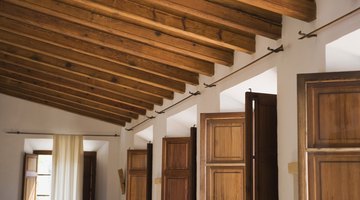How Do I Identify Old Ceiling Insulation?
When preparing for renovations of older homes, you will likely encounter old insulation. Depending on the type, it could be dangerous to your health, damaged or simply too old to be as effective as modern insulation. Learn how to identify old ceiling insulation.

Insulation Types
First, you should understand the different types of insulation. There are five main types of insulation that you may encounter. Loose-fill insulation consists of natural or man-made fibers that are blown into the ceiling cavity. Batt or blanket insulation is made from glass or cotton fiber and comes in roll form, usually in widths of 16 or 24 inches. Rigid insulation is extruded into board form and is often made of plastic. Foam insulation is sprayed into place and expands to fill the cavity. Radiant barriers, which are usually installed in the attic, have aluminum foil backing to prevent heat from radiating through.
Identifying Old Insulation
Some of the insulation types discussed above are the result of new technology. Older types of insulation include loose-fill or batt fiberglass, which can be pink, yellow or white. While this type is often still used, older insulation may be discolored or torn and is therefore less effective. If the insulation is wool-like and gray, it may be loose-fill rockwool. If it is white, however, it may be a newer product. Shredded newspaper, or loose-fill cellulose, was another common insulation in the past. Vermiculite and Perlite are older granulated insulations with relatively low R-values, which describes the product's thermal resistance. Sometimes, wood products such as sawdust or balsa wood were used at insulation in old homes, but these are very ineffective.
While it may be acceptable to leave some older insulation types in place, replacing it with new insulation with a higher R-value will result in energy savings.
Dangerous Old Insulation
Two types of old insulation that are dangerous to your health are urea formaldehyde foam, which is usually gray or yellow and brittle, and asbestos. Formaldehyde off-gasing is a concern, so this product is no longer on the market. Most people are aware of the dangers of asbestos, which may cause cancer and other health problems. If you suspect your home contains asbestos insulation, you should not remove it yourself. Instead, hire an asbestos abatement contractor to safely remove this insulation before proceeding with any renovations.
The Drip Cap
- When preparing for renovations of older homes, you will likely encounter old insulation.
- First, you should understand the different types of insulation.
- Rigid insulation is extruded into board form and is often made of plastic.
- While it may be acceptable to leave some older insulation types in place, replacing it with new insulation with a higher R-value will result in energy savings.
- Two types of old insulation that are dangerous to your health are urea formaldehyde foam, which is usually gray or yellow and brittle, and asbestos.
References
Writer Bio
Dorian Gray has been a full-time freelance writer since 2009. She has written extensively on the topics of architecture and design for national magazines such as "Architectural Record" and regional publications such as "At Home in Arkansas." Gray also writes about the topics of beauty, health, nutrition and travel. She holds a Bachelor of Architecture from the University of Arkansas.
Photo Credits
- Jupiterimages /Polka Dot/Getty Images
- Jupiterimages /Polka Dot/Getty Images
More Articles



